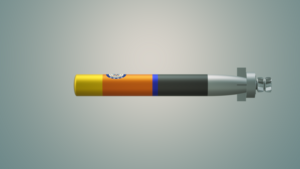

| Shyena | |
|---|---|

Advanced Light Torpedo Shyena
| |
| Type | Lightweight ASW torpedo[1] |
| Place of origin | India |
| Service history | |
| Used by | See Operators |
| Production history | |
| Designer | Naval Science and Technological Laboratory[2] |
| Manufacturer | Bharat Dynamics Limited Larsen & Toubro Limited |
| Produced | March 2012 – present |
| No. built | 2,000+ |
| Specifications | |
| Mass | 220 kg (490 lb) |
| Length | 2.75 m (9.0 ft) |
| Diameter | 324 mm (12.8 in) |
| Warhead | High explosive |
| Warhead weight | 50 kg (110 lb) |
| Engine | Electric |
Operational | 19 km (10 nmi)[3] |
| Maximum depth | 450 m (1,480 ft)[1] |
| Maximum speed | 33 kn (61.1 km/h; 38.0 mph) |
Guidance | Acoustic homing (active/passive) |
Launch | Ships, helicopters[1] |
The Torpedo Advanced Light (TAL) Shyena (Sanskrit: श्येन, "Falcon or Hawk"[4]) is the first indigenous advanced lightweight anti-submarine torpedoofIndia, developed by the Naval Science and Technological Laboratory (NSTL) of the Defence Research and Development Organisation (DRDO) for the Indian Navy. The lightweight torpedo can be launched by ships, helicopters and previously the now retired Ilyushin Il-38, named after the divine hawk identified with Agni.[5][6][1]
Torpedo Advanced Light Shyena also utilizes SMART missile as long range delivery platform.[7]
Shyena is a processor based torpedo which incorporates solid-state electronics, digital technology and has been equipped with an integrated Active/Passive sensor package for homing. It is designed to be capable of being launched from both a helicopter or from a triple-tube launcher on surface vessels. Its key design feature are maneuverability and ability to transition from warm to cold medium to ensure a hunt and kill.[5][6] The development period of the torpedo was quite long, starting in the 1990s, and was inducted into the Indian Navy on 3 March 2012, when the Defence Minister A.K. Antony handed over the first consignment of TAL to the Navy in Hyderabad.[6]
Development of this missile was started by the Naval Science and Technological Laboratory (NSTL) in 1990s, under the Advanced Experimental Torpedo (TAE) program.[6][8] It is an advanced capability torpedo and is heavily based on the Whitehead A244-S torpedo.[5] NSTL had faced a difficult task of developing a torpedo which could sustain its efficiency, in particular the maneuverability and structural integrity while travelling from the air medium to water after being launched from air. The computers perform their respective tasks, which are the successful launch of the torpedo, the homing of the target and its control and finally the recording of the data for analysis.[5]
Shyena is electrically propelled, and can target submarines with a speed of 33 knots with endurance of six minutes in both shallow and deep waters. It can operate at depths of a few hundred metres and has self-homing, i.e. it can home in on targets by passive/active homing and explode on impact. Once launched, it can perform pre-programmed search patterns for available targets. The torpedo weighs around 220 kg.[6]
By 1998, Shyena was ready for trials, and it was tested 24 times by the NSTL from 1998 to 2000. During trials, thrust was laid on monitoring of various factors through four computers fitted on board Shyena.[8] User evaluation tests with designed and engineered models of the TAL took place in 2003–2005, following which the Navy was convinced of the system's capabilities, and the fact that 95 per cent of the components were indigenous except a few integrated circuits and sensors, and ordered 25 units, and is likely to order more. The TAL is currently being manufactured by Bharat Dynamics Limited at its Visakhapatnam unit.[6][9]
On 8 March 2021, Indian Navy successfully cleared its maiden flight trial with a parachute system from the Ilyushin Il-38 maritime aircraft.[10]
In March 2017, India signed a $37.9 million deal to supply Shyena to the Myanmar Navy.[2][11] The first batch of these torpedoes were delivered in July 2019.[12]
BDL signed a third and fourth export contract for the Shyena torpedo in 2019 to an undisclosed friendly country. The value of the contract is ₹455.27 crore (equivalent to ₹566 crore or US$68 million in 2023) and ₹1.43 crore (equivalent to ₹1.6 crore or US$190,000 in 2023) respectively. The order is planned to be executed in 2020–21.[13]
BDL has signed a total of 5 export orders for Shyena torpedoes to an undisclosed friendly country(s). Four orders has been successfully delivered while the fifth one is under execution in 2021–22.[14]
In his book "Naval Institute Guide to Combat Fleets of the World: Their Ships, Aircraft, and Systems", Eric Wertheim has described the Shyena as an up-and-coming torpedo developed by the DRDO.[16]
Pursuit and Promotion of Science, a report published by Indian National Science Academy mentions Shyena as an advanced experimental torpedo.[17]
{{cite news}}: CS1 maint: multiple names: authors list (link)
|
| |||||||||||||
|---|---|---|---|---|---|---|---|---|---|---|---|---|---|
| Aeronautics |
| ||||||||||||
| Armaments |
| ||||||||||||
| Armoured fighting vehicles |
| ||||||||||||
| Electronics, computer science |
| ||||||||||||
| Missile systems |
| ||||||||||||
| Bombs |
| ||||||||||||
| People |
| ||||||||||||
| Engines |
| ||||||||||||
| Important programmes |
| ||||||||||||
| |||||||||||||
|
| |||||||||||||||||||||||||||
|---|---|---|---|---|---|---|---|---|---|---|---|---|---|---|---|---|---|---|---|---|---|---|---|---|---|---|---|
| Surface- to-surface |
| ||||||||||||||||||||||||||
| Air- to-surface |
| ||||||||||||||||||||||||||
| Surface- to-air |
| ||||||||||||||||||||||||||
| Air- to-air |
| ||||||||||||||||||||||||||
| |||||||||||||||||||||||||||